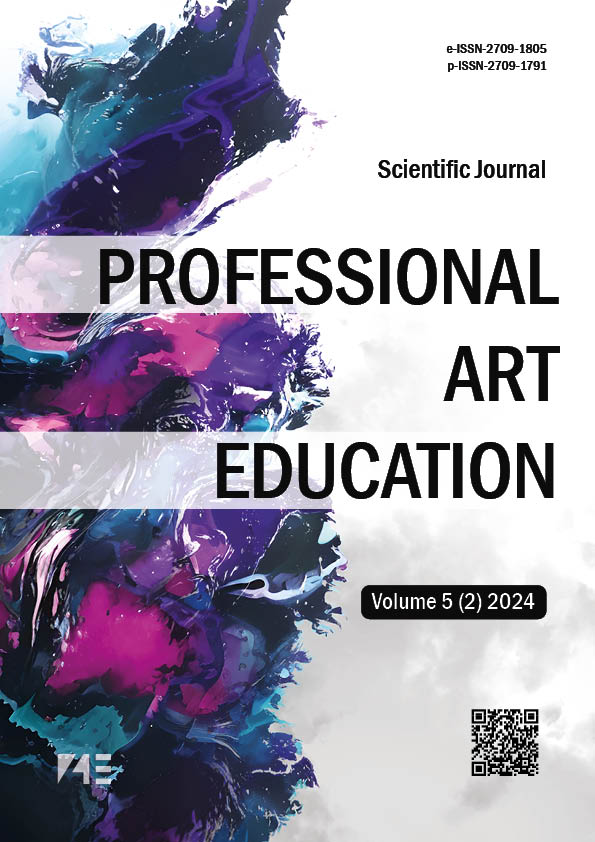Distance learning in art majors of higher education institutions
on the example of the Faculty of Arts in H.S. Skovoroda Kharkiv National Pedagogical University
DOI:
https://doi.org/10.34142/27091805.2024.5.02.06Keywords:
distance learning, arts education, higher education institutions, online platforms, interactive methods, feedbackAbstract
Object. The purpose of this publication is to summarize and systematize the experience of distance learning at the Faculty of Arts of H.S. Skovoroda Kharkiv National Pedagogical University, identifying the strengths and weaknesses of this form of education in the context of the specific nature of arts disciplines. The objectives of the article focus on evaluating the potential of distance learning for the development of arts education, identifying its advantages and possibilities for individualizing the learning process, as well as determining the main challenges faced by students and faculty in the distance learning format, particularly those related to the specificities of creative processes, practical lessons, and assessment.
Methods and Methodology. The study employs traditional theoretical methods of analyzing scientific literature, curricula, methodological materials, and reports to understand the theoretical foundations and practical implementation of distance learning in arts education. In the course of the research, methods such as observation of online learning processes (online classes, forums, chats) were used to identify the features of student-teacher interaction and assess the impact of distance learning on the quality of creative assignments.
Research Results. The article offers a detailed analysis of the distance learning experience at the Faculty of Arts of H.S. Skovoroda Kharkiv National Pedagogical University in key arts specialties: 014.13 Secondary Education (Music), 014.14 Secondary Education (Visual Arts), 022 Design, 024 Choreography. The authors examine how the university has adapted its educational process to contemporary challenges, focusing on aspects such as the use of online platforms, interactive teaching methods, and feedback between participants in the educational process. The article deeply analyzes the problems faced by students and instructors of arts disciplines during distance learning. Among these are the lack of direct contact with the instructor, limited access to specialized equipment, and difficulties in developing practical skills and creative collaboration. The authors provide specific recommendations for improving the organization of distance learning at the Faculty of Arts. They develop strategies to overcome challenges and maximize the benefits of the distance learning format.
Conclusions. The study demonstrates that, despite certain challenges related to the specifics of arts disciplines, distance learning at the Faculty of Arts of H.S. Skovoroda Kharkiv National Pedagogical University allows for high-quality education and the development of students’ creative abilities. The authors offer a range of practical recommendations that may be useful for other higher education
institutions.
Downloads
References
аврілова, Л., & Катасонова, Ю. (2017). Теоретичні аспекти впровадження дистанційного навчання в Україні. Освітологічний дискурс, 168–182. https://doi.org/10.28925/2312-5829.2017.1-2.1682
Алтухова, А.В., Ростовцева, Н.С. (2021). Можливості використання дистанційного навчання у підготовці майбутніх вчителів образотворчого мистецтва. Scientific collection «interconf», (58), 97–103. http://dspace.hnpu.edu.ua/handle/123456789/6838
Бондаренко, А. (2019). Дистанційна освіта музикантів-виконавців: проблеми та перспективи. Імідж сучасного педагога, №5 (194), C.80-81 https://doi.org/10.33272/2522-9729-2020-3(192)-69-72
Васильєва, О.В. (2021). Організація викладання хорового диригування з використанням дистанційної платформи MOODLE. Диригентсько-хорова освіта: синтез теорії та практики (с. 6–9). ХНУМ імені І.П. Котляревського.
Васильєва, О.В., Мартиненко, І.І., Королевська, Т.О. (2023). Підготовка та організація кваліфікаційного іспиту з диригування хором в умовах дистанційного навчання. Час мистецької освіти. Мистецька освіта: реалії та перспективи розвитку (с. 175–182). ХНПУ імені Г.С. Сковороди.
Васильєва, Т.А., Котенко, С.І. (2023). Проблеми і перспективи розвитку онлайн-освіти. Сумський державний університет. https://essuir.sumdu.edu.ua/bitstream/123456789/92574/1/Vasyl%CA%B9yeva.pdf
Григорова, Л.С., Житєньова, Н.В. (2022). Особливості викладання дизайнерських дисциплін в умовах воєнного стану. Modern and global methods of the development of scientific thought (с. 350–355). Italy. https://dspace.hnpu.edu.ua/handle/123456789/9265
Єфімова, О., Барабаш, О., Подкопай Є., Сидоренко В. (2023). Проблеми вивчення хореографічних дисциплін в умовах дистанційного навчання. Витоки педагогічної майстерності., (32), 124–127.
Карпенко, Є. (2021). Дистанційне вивчення хорових дисциплін: втрати та знахідки. Актуальнi питання гуманiтарних наук., 1(39), 345–351. https://doi.org/10.24919/2308-4863/39-1-57
Лондар, Л. (2022). Щодо забезпечення дистанційного навчання в Україні в умовах війни. Освіта України в умовах воєнного стану: управління, цифровізація, євроінтеграційні аспекти (с. 36–40). ДНУ «Інститут освітньої аналітики». https://kerivnyk.info/2022/10/londar.html
Мартиненко, С. (2020). Забезпечення якості університетської освіти в умовах змішаного та дистанційного навчання. Неперервна професійна освіта: теорія і практика , (4), 7–13. https://doi.org/10.28925/1609-8595.2020.4.1
Парфентьєва, І. П. (2023). Особливості проведення занять з дисциплін диригентсько-хорового циклу в умовах дистанційного навчання. Час мистецької освіти. Мистецька освіта: реалії та перспективи розвитку (с. 151–153). ХНПУ імені Г. С. Сковороди.
Положення про використання технологій дистанційного навчання в освітньому процесі харківського національного педагогічного університету імені Г.С. Сковороди (2021) (Харківська область) (Україна). http://surl.li/mvienv
Положення про стажування педагогічних і науково-педагогічних працівників на платформі дистанційної освіти MOODLE (ВС-16) (2022) (Харківська область) (Україна). http://surl.li/pusogl
Про затвердження Положення про дистанційне навчання, Наказ Міністерства освіти і науки України № 466 (2024) (Україна). https://zakon.rada.gov.ua/laws/show/z0703-13#Text
Ржечицька, С. А. (2022). Проблеми та переваги дистанційного навчання в мистецьких закладах вищої освіти. Бібліотекознавство. Документознавство. Інформологія., (3), 100–105. http://elib.nakkkim.edu.ua/handle/123456789/4561
Соколова, А. (2022). Інтерактивні форми і методи дистанційного навчання майбутніх учителів музичного мистецтва. Professional Art Education, 3(1), 6-16. https://doi.org/10.34142/27091805.2022.3.01.01
Downloads
Published
License
Copyright (c) 2024 Оксана Васильєва, Володимир Фомін (Автор)

This work is licensed under a Creative Commons Attribution-NonCommercial 4.0 International License.














